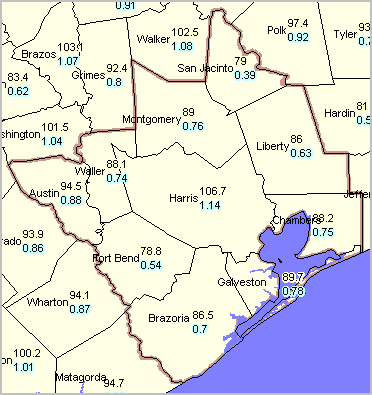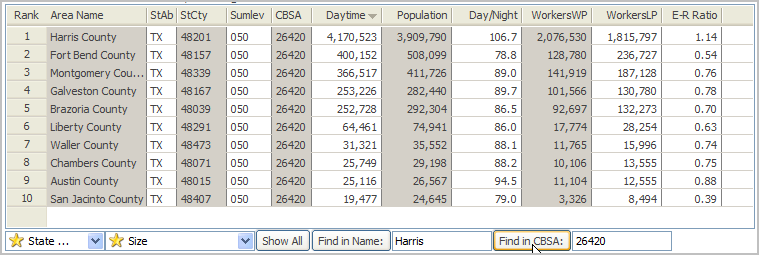|
|
America's Urban Population Urban Agglomerations & Census 2010 Related Sections - Applications Gallery - States - Metros - Congressional District - Counties - Cities/Places - Tracts/Neighborhoods - ZIP Codes - Urban Areas Demographic-Economic Estimates-Projections GIS Thematic Mapping Visual Analysis Tools Ranking Tables National Scope Demographic Change 2000-2010 - States - Metros - Congressional District - School Districts - Counties - Cities/Places - Census Tracts |
State & County Daytime Population; ACS 2009
The most current data on city, county, state daytime population is located at http://proximityone.com/daytime_population.htm. The concept of the daytime population refers to the number of people who are present in an area during normal business hours, including workers. This is in contrast to the resident population present during the evening and nighttime hours. Information on the expansion or contraction experienced by different communities between nighttime and daytime populations is important for many planning purposes, including those dealing with market size, trade/service areas, transportation, disaster, and relief operations. Use the interactive ranking table below to examine characteristics of all U.S. states and counties. Data are based on the 2009 ACS 5-year estimates (centric to mid-2007). These data will update with 2010 ACS 5-year estimates (centric to 2008) in December 2011. We develop custom estimates and projections of daytime population, for one or many areas, that incorporate results of Census 2010. Contact us for information about custom estimates and projections and/or subscribing to use the data shown in the table on your computer. Mention 'daytime population' in the text section. Employment-Residence (E-R) The far right column (see description of all columns below table) shows the Employment-Residence (E-R) ratio. The E-R Ratio is a measure of the total number of workers working in a place (WorkersWP), relative to the total number of workers living in the area (WorkersLP). The E-R Ratio is a rough indicator of the jobs-workers balance in an area, although it does not take into account whether the resident workers possess the skills needed for the jobs that are available. E-R Ratios greater than 1.00 occur when there are more workers working in the place than living there. These areas can be considered as net importers of labor. More below about why some E-R values are -1. State & County Daytime Population; ACS 2009 -- interactive ranking table Click column header to sort; click again to sort other direction. Click ShowAll button between queries (Find in Name or Find in CBSA or by Sumlev). See related Ranking Tables Main Page Workers defined. People 16 years and over who were employed and at work during the reference week. The estimate of workers includes part-time and full-time civilian personnel and people in the Armed Forces. Daytime population universe. The daytime population estimates in the table adjusts only for work-related travel, i.e., incommuters to an area and outcommuters from an area. Data necessary to adjust for shopping, school, recreation, tourism, etc. are not available. Table Usage Notes • Click on a column header to sort on that column; click column header again to sort in other direction. • Click ShowAll button to show all areas and restore full set of data view. • Click State (dropdown below table) to view metros in a selected state (click ShowAll between selections). • Find by Name: key in partial area name in text box to right of Find-in-Name button then click button to locate all matches (case sensitive). • Find by CBSA: key in exact 5-character CBSA code in text box to right of Find-in-CBSA button then click button to show all counties in this CBSA. • See related ranking tables. Columns: CBSA -- Core-Based Statistical Area code; get code for CBSA/metro here: http://proximityone.com/metros/guide/misa_msa.htm. Daytime -- Estimated daytime population – this is the estimate arrived at by adjusting the total resident population by the number of incommuters and outcommuters to the area. It does not adjust for people entering or leaving the area for purposes other than commuting, nor does the commuting adjustment take the time of day of the work trips into account. The estimate is calculated by adding the total resident population (Population) and the total workers working in the area (WorkersWP), and then subtracting from that result the total workers living in the area (WorkersLP). This method yields the same result as would be obtained by adding the incommuters and subtracting the outcommuters from the total resident population. Population -- Total resident population – the total number of persons living in the area. Day/Resident -- 100 * (daytime population/resident population). WorkersWP -- Total workers working in the area – this is the number of workers who reported working in the area, regardless of their place of residence. In other words, it is the total that worked there no matter where they lived. Residence locations are not considered, only workplace locations are reflected in this number. WorkersLP -- Total workers living in the area – sometimes referred to as the number of resident workers. It is the number of people living in the area who are workers. It includes workers who live there regardless of where they worked, or in other words, no matter where their workplace was located. Place of work location is not considered, only residence location is reflected in this number. ER Ratio-- Employment-Residence (E-R) ratio – this is a measure of the total number of workers working in an area (WorkersWP), relative to the total number of workers living in the area (WorkersLP). It is often used as a rough indication of the jobs-workers balance in an area, although it does not take into account whether the resident workers possess the skills needed for the jobs that are available. E-R ratios greater than 1.00 occur when there are more workers working in the area than living there. These areas can be considered as net importers of labor. For example, an E-R ratio of 1.19 means that there are 19 percent more workers working in the area than living in the area. Values less than 1.00 indicate places that send more workers to other areas than they receive, i.e., they are net exporters of labor. An E-R value of -1 indicates the measure was not computed, normally because the WorkersLP value was zero. For the same reason, an E-R value of zero can be due to WorkersWP having a value of zero. Cells with blank/no value indicates this item was not available in ACS 2009. Any computation making use of this cell treated the cell value as zero. Visual Analysis of Daytime Population Patterns The following graphic shows the 10-county Houston MSA (brown boundary) with county labels. E-R ratio values are shown with blue labels. The daytime/nighttime ratio values are shown with yellow labels. The Harris County E-R ratio of 1.14 means that there are 14 percent more workers working in the county than living in the county. Use the CommunityViewer GIS software and the daytime demographics datasets to visually examine your areas of interest. Contact us for more information. Mention 'daytime population visual anlaysis' in the text section. 
The following graphic shows a static view/capture of the ranking table view using Find in CBSA with the CBSA set to 26420 -- the Houston MSA. Only the Houston MSA counties are displayed; the table has been ranked on Daytime population in descending order. Perform this type of query for any metro and view characteristics of counties in that metro. 
Additional Information Proximity develops geodemographic-economic data and analytical tools and helps organizations knit together and use diverse data in a decision-making and analytical framework. We develop custom demographic/economic estimates and projections, develop geographic and geocoded address files, and assist with impact and geospatial analyses. Wide-ranging organizations use our tools (software, data, methodologies) to analyze their own data integrated with other data. Contact Proximity (888-364-7656) with questions about data covered in this section or to discuss custom estimates, projections or analyses for your areas of interest. |
|
|